The Impact of Environmental Courts on Green Total Factor Productivity in Chinese Cities
Abstract
1. Introduction
2. Literature Review and Research Hypothesis
2.1. Research on Environmental Courts
2.2. Research on GTFP
2.3. Research Hypothesis
3. Environmental Courts in China and the GTFP Calculation
3.1. Environmental Courts in China
3.2. GTFP Calculation
4. Material and Methods
4.1. Variables and Data Sources
4.1.1. Independent Variable
4.1.2. Dependent Variable
4.1.3. Controlled Variables
4.1.4. Mediating Variables
4.1.5. Moderator Variables
4.1.6. Other Variables
4.2. The Baseline Model
4.3. Mechanism Test Model
5. Results
5.1. Descriptive Statistics
5.2. Baseline Regression Results
5.3. Robustness Test Results
5.3.1. Parallel Trends Test
5.3.2. Placebo Test
5.3.3. PSM-DID
5.4. Mediation Effect Analysis
5.5. Moderation Effect Analysis
5.6. Heterogeneity Analysis
6. Conclusions
- (1)
- Environmental courts increased the efficiency of green economic development by reducing carbon intensity. This conclusion remained valid following a battery of robustness tests.
- (2)
- The establishment of environmental courts not only signified the improvement of judicial environmental regulation but also strengthened the administrative regulatory power of the government. The combined effect of various environmental regulatory measures prompted cities to transition to a greener development approach.
- (3)
- The financial support of local financial institutions and green technology innovation helped to induce the positive effect of the environmental court.
- (4)
- Environmental courts had more impact on promoting green economic development in the western regions and non-low-carbon pilot cities of China. Comparatively, their influence was relatively smaller in the more economically developed eastern and central regions and was not significant in low-carbon pilot cities.
7. Discussion and Policy Implications
7.1. Discussion
7.2. Policy Implications
7.3. Limitations
Author Contributions
Funding
Institutional Review Board Statement
Informed Consent Statement
Data Availability Statement
Conflicts of Interest
References
- Yang, X.; Jin, K.; Duan, Z.; Gao, Y.; Sun, Y.; Gao, C. Spatial-temporal differentiation and influencing factors of carbon emission trajectory in Chinese cities—A case study of 247 prefecture-level cities. Sci. Total Environ. 2024, 928, 172325. [Google Scholar] [CrossRef] [PubMed]
- Xu, J.; Xu, M.; Zhao, Y.; Wang, S.; Tao, M.; Wang, Y. Spatial-temporal distribution and evolutionary characteristics of water environment sudden pollution incidents in China from 2006 to 2018. Sci. Total Environ. 2021, 801, 149677. [Google Scholar] [CrossRef]
- Mangla, S.K.; Luthra, S.; Jakhar, S.; Gandhi, S.; Muduli, K.; Kumar, A. A step to clean energy—Sustainability in energy system management in an emerging economy context. J. Clean. Prod. 2020, 242, 118462. [Google Scholar] [CrossRef]
- Sun, Y.H.; Ding, W.W.; Yang, Z.Y.; Yang, G.C.; Du, J.T. Measuring China’s regional inclusive green growth. Sci. Total Environ. 2020, 713, 136367. [Google Scholar] [CrossRef]
- Li, R.Y.M.; Wang, Q.Q.; Zeng, L.Y.; Chen, H. A Study on Public Perceptions of Carbon Neutrality in China: Has the Idea of ESG Been Encompassed? Front. Environ. Sci. 2023, 10, 949959. [Google Scholar] [CrossRef]
- Zhang, K.; Liu, Y.T. A review of the system of “daily continuous penalty” in China’s environmental protection practice-From the perspective of law and economics. Environ. Impact Assess. Rev. 2023, 98, 106976. [Google Scholar] [CrossRef]
- Du, W.J.; Li, M.J. Assessing the impact of environmental regulation on pollution abatement and collaborative emissions reduction: Micro-evidence from Chinese industrial enterprises. Environ. Impact Assess. Rev. 2020, 82, 106382. [Google Scholar] [CrossRef]
- Allen, F.; Qian, J.; Qian, M.J. Law, finance, and economic growth in China. J. Financ. Econ. 2005, 77, 57–116. [Google Scholar] [CrossRef]
- Zhao, Y.H.; Zheng, L.; Zhu, J.Z. Could environmental courts reduce carbon intensity? Evidence from cities of China. J. Clean. Prod. 2022, 377, 134444. [Google Scholar] [CrossRef]
- He, W.M.; Wang, B. Environmental jurisdiction and energy efficiency: Evidence from China’s establishment of environmental courts. Energy Econ. 2024, 131, 107358. [Google Scholar] [CrossRef]
- Fan, Z.; Zhao, R. Does rule of law promote pollution control? Evidence from the establishment of the environmental court. Econ. Res. J. 2019, 54, 21–37. [Google Scholar]
- Gao, W.Y.; Wang, Y.Z.; Wang, F.R.; Mbanyele, W. Do environmental courts break collusion in environmental governance? Evidence from corporate green innovation in China. Q. Rev. Econ. Financ. 2024, 94, 133–149. [Google Scholar] [CrossRef]
- Yuan, H.X.; Zou, L.H.; Feng, Y.D. How to achieve emission reduction without hindering economic growth? The role of judicial quality. Ecol. Econ. 2023, 209, 107839. [Google Scholar] [CrossRef]
- Pearlman, M.L. The land and environment court of New South Wales—A model for environmental protection. Water Air Soil Pollut. 2000, 123, 395–407. [Google Scholar] [CrossRef]
- Preston, B.J. Characteristics of Successful Environmental Courts and Tribunals. J. Environ. Law 2014, 26, 365–393. [Google Scholar] [CrossRef]
- Angstadt, J.M. Can Domestic Environmental Courts Implement International Environmental Law? A Framework for Institutional Analysis. Transnatl. Environ. Law 2023, 12, 318–342. [Google Scholar] [CrossRef]
- Deng, J.J.; Li, M.X.; Li, Y.; Lu, J. Effect of Environmental Courts on Pollution Abatement: A Spatial Difference-in-Differences Analysis. Sustainability 2024, 16, 1452. [Google Scholar] [CrossRef]
- Network, C.C. The Report on the Development of Environmental Justice in China (2019). Available online: https://www.chinacourt.org/article/detail/2020/05/id/5195810.shtml (accessed on 5 October 2023).
- Walters, R.; Westerhuis, D.S. Green crime and the role of environmental courts. Crime Law Soc. Change 2013, 59, 279–290. [Google Scholar] [CrossRef]
- Stern, R.E. The Political Logic of China’s New Environmental Courts. China J. 2014, 72, 53–74. [Google Scholar] [CrossRef]
- Zhang, Q.; Yu, Z.; Kong, D.M. The real effect of legal institutions: Environmental courts and firm environmental protection expenditure. J. Environ. Econ. Manag. 2019, 98, 102254. [Google Scholar] [CrossRef]
- Yu, W. Challenges and solutions for China’s environmental court in context of environmental judicial specialization. China Popul. Resour. Environ. 2017, 27, 62–68. [Google Scholar]
- Supreme People’s Court of China. Environment and Resources Adjudication in China; Supreme People’s Court of China: Beijing, China, 2020; p. 42.
- Jin, Z.N. Environmental Impact Assessment Law in China’s courts: A study of 107 judicial decisions. Environ. Impact Assess. Rev. 2015, 55, 35–44. [Google Scholar] [CrossRef]
- Huang, X.Q.; Liu, W.; Cao, Z. Environmental courts and foreign direct investments: Evidence from China. Environ. Sci. Pollut. Res. 2022, 29, 31400–31412. [Google Scholar] [CrossRef] [PubMed]
- Hou, X.S.; Yang, J.; Hou, C.H. Can strengthening environmental justice promote carbon reduction? Evidence from environmental courts in China. Environ. Sci. Pollut. Res. 2024, 1–18. [Google Scholar] [CrossRef]
- Chen, X.H.; Zhou, P.; Hu, D.B. Influences of the ongoing digital transformation of the Chinese Economy on innovation of sustainable green technologies. Sci. Total Environ. 2023, 875, 162708. [Google Scholar] [CrossRef] [PubMed]
- Cao, J.H.; Law, S.H.; Samad, A.R.B.; Mohamad, W.; Wang, J.L.; Yang, X.D. Effect of financial development and technological innovation on green growth-Analysis based on spatial Durbin model. J. Clean. Prod. 2022, 365, 132865. [Google Scholar] [CrossRef]
- Cabernard, L.; Pfister, S. A highly resolved MRIO database for analyzing environmental footprints and Green Economy Progress. Sci. Total Environ. 2021, 755, 142587. [Google Scholar] [CrossRef]
- Ma, Y.H.; Lin, T.; Xiao, Q.F. The Relationship between Environmental Regulation, Green-Technology Innovation and Green Total-Factor Productivity-Evidence from 279 Cities in China. Int. J. Environ. Res. Public Health 2022, 19, 16290. [Google Scholar] [CrossRef]
- Lyu, Y.; Wang, W.; Wu, Y.; Zhang, J. How does digital economy affect green total factor productivity? Evidence from China. Sci. Total Environ. 2023, 857, 159428. [Google Scholar] [CrossRef]
- Zhang, W.; Ge, Y. The Spatial Effect Analysis of OFDI on Green Total Factor Productivity. Chin. J. Manag. Sci. 2021, 29, 26–35. [Google Scholar]
- Wang, S.S.; Xiao, S.Y.; Lu, X.X.; Zhang, Q.D. North-south regional differential decomposition and spatiotemporal dynamic evolution of China’s industrial green total factor productivity. Environ. Sci. Pollut. Res. 2023, 30, 37706–37725. [Google Scholar] [CrossRef]
- Tong, D.; Zhang, Q.; Zheng, Y.X.; Caldeira, K.; Shearer, C.; Hong, C.P.; Qin, Y.; Davis, S.J. Committed emissions from existing energy infrastructure jeopardize 1.5 °C climate target. Nature 2019, 572, 373–377. [Google Scholar] [CrossRef] [PubMed]
- Chen, Y.F.; Liu, K.L.; Ni, L.F.; Chen, M.X. Impact of carbon lock-in on green economic efficiency: Evidence from Chinese provincial data. Sci. Total Environ. 2023, 892, 164581. [Google Scholar] [CrossRef] [PubMed]
- Peng, X. Strategic interaction of environmental regulation and green productivity growth in China: Green innovation or pollution refuge? Sci. Total Environ. 2020, 732, 139200. [Google Scholar] [CrossRef] [PubMed]
- Zhao, S.K.; Cao, Y.Q.; Feng, C.; Guo, K.; Zhang, J.N. How do heterogeneous R&D investments affect China’s green productivity: Revisiting the Porter hypothesis. Sci. Total Environ. 2022, 825, 154090. [Google Scholar] [CrossRef]
- Zhu, Y.; Zhang, Y.; Piao, H. Does agricultural mechanization improve the green total factor productivity of China’s planting industry? Energies 2022, 15, 940. [Google Scholar] [CrossRef]
- Zhang, H.P.; Dong, Y. Measurement and Spatial Correlations of Green Total Factor Productivities of Chinese Provinces. Sustainability 2022, 14, 5071. [Google Scholar] [CrossRef]
- Zhao, P.Y.; Wu, H.Y.; Lu, Z.G.; Kou, J.L.; Du, J. Spatial differences, distributional dynamics, and driving factors of green total factor productivity in China. Front. Environ. Sci. 2022, 10, 1058612. [Google Scholar] [CrossRef]
- Cui, H.R.; Wang, H.R.; Zhao, Q.Z. Which factors stimulate industrial green total factor productivity growth rate in China? An industrial aspect. Greenh. Gases-Sci. Technol. 2019, 9, 505–518. [Google Scholar] [CrossRef]
- Li, T.H.; Ma, J.H.; Mo, B. Does Environmental Policy Affect Green Total Factor Productivity? Quasi-Natural Experiment Based on China’s Air Pollution Control and Prevention Action Plan. Int. J. Environ. Res. Public Health 2021, 18, 8216. [Google Scholar] [CrossRef]
- Shen, J.; Sun, H.; Yang, R.; Shao, J. An Empirical Study of China’s Environmental Economic Policy and the Effect of Industrial Green Transformation—Based on Data Envelopment Analysis Model. In Proceedings of the International Conference on Information Economy, Data Modeling and Cloud Computing, ICIDC 2022, Qingdao, China, 17–19 June 2022. [Google Scholar]
- Liu, P.D.; Zhu, B.Y. Temporal-spatial evolution of green total factor productivity in China’s coastal cities under carbon emission constraints. Sustain. Cities Soc. 2022, 87, 104231. [Google Scholar] [CrossRef]
- Wang, K.L.; Pang, S.Q.; Zhang, F.Q.; Miao, Z.; Sun, H.P. The impact assessment of smart city policy on urban green total-factor productivity: Evidence from China. Environ. Impact Assess. Rev. 2022, 94, 106756. [Google Scholar] [CrossRef]
- Shi, Y. The Impact and Spillover Effects of Environmental Regulation on GTFP. SHS Web Conf. 2023, 154, 03023. [Google Scholar] [CrossRef]
- Feng, X.W.; Xin, M.S.; Cui, X.H. The spatial characteristics and influencing factors of provincial green total factor productivity in china-based on the spatial durbin model. Fresenius Environ. Bull. 2021, 30, 8705–8716. [Google Scholar]
- Wang, B.; Wang, C. Green Finance and Technological Innovation in Heavily Polluting Enterprises: Evidence from China. Int. J. Environ. Res. Public Health 2023, 20, 3333. [Google Scholar] [CrossRef] [PubMed]
- Neagu, F.; Tatarici, L.; Dragu, F.; Stamate, A. Are green loans less risky? Micro-evidence from a European Emerging Economy. J. Financ. Stab. 2024, 70, 101208. [Google Scholar] [CrossRef]
- Kesidou, E.; Wu, L. Stringency of environmental regulation and eco-innovation: Evidence from the eleventh Five-Year Plan and green patents. Econ. Lett. 2020, 190, 109090. [Google Scholar] [CrossRef]
- Han, L.; Xiao, Z.J.; Yu, Y.Z. Environmental judicature and enterprises’ green technology innovation: A revisit of the porter hypothesis. J. Asian Econ. 2024, 91, 101693. [Google Scholar] [CrossRef]
- Tao, S.; Hai, M.D.; Fang, Z.W.; Zheng, D.C. The role of environmental justice reform in corporate green transformation: Evidence from the establishment of China’s environmental courts. Front. Environ. Sci. 2023, 11, 1090853. [Google Scholar] [CrossRef]
- Wang, T.H.; Song, Z.; Zhou, J.; Sun, H.P.; Liu, F.Q. Low-Carbon Transition and Green Innovation: Evidence from Pilot Cities in China. Sustainability 2022, 14, 7264. [Google Scholar] [CrossRef]
- Song, Q.J.; Qin, M.; Wang, R.C.; Qi, Y. How does the nested structure affect policy innovation?: Empirical research on China’s low carbon pilot cities. Energy Policy 2020, 144, 111695. [Google Scholar] [CrossRef]
- Qi, X.L.; Wu, Z.F.; Xu, J.Q.; Shan, B.O. Environmental justice and green innovation: A quasi-natural experiment based on the establishment of environmental courts in China. Ecol. Econ. 2023, 205, 107700. [Google Scholar] [CrossRef]
- Li, S.-E.; Cheng, K.-M. Do large cities have a productivity advantage in China? From the perspective of green total factor productivity growth. J. Clean. Prod. 2022, 379, 134801. [Google Scholar] [CrossRef]
- Zhao, X.; Nakonieczny, J.; Jabeen, F.; Shahzad, U.; Jia, W. Does green innovation induce green total factor productivity? Novel findings from Chinese city level data. Technol. Forecast. Soc. Change 2022, 185, 122021. [Google Scholar] [CrossRef]
- Guan, Y.; Wang, H.; Guan, R.; Ding, L. Measuring inclusive green total factor productivity from urban level in China. Front. Environ. Sci. 2022, 10, 966246. [Google Scholar] [CrossRef]
- Statistics, N.B.O. China Regional Economic Statistical Yearbook. Available online: https://navi.cnki.net/knavi/yearbooks/YZXDR/detail?uniplatform=NZKPT (accessed on 28 October 2023).
- Statistics, N.B.O. China City Statistical Yearbook. Available online: https://navi.cnki.net/knavi/yearbooks/YZGCA/detail?uniplatform=NZKPT (accessed on 26 October 2023).
- CSMAR. CSMAR Database. Available online: https://data.csmar.com/ (accessed on 21 October 2023).
- CEIC. CEIC Database. Available online: https://www.ceicdata.com.cn/zh-hans (accessed on 28 October 2023).
- Zhao, P.-J.; Zeng, L.-E.; Lu, H.-Y.; Zhou, Y.; Hu, H.-Y.; Wei, X.-Y. Green economic efficiency and its influencing factors in China from 2008 to 2017: Based on the super-SBM model with undesirable outputs and spatial Dubin model. Sci. Total Environ. 2020, 741, 140026. [Google Scholar] [CrossRef] [PubMed]
- CEASDs. CEASDs Database. Available online: https://www.ceads.net.cn/ (accessed on 19 October 2023).
- Shan, Y.; Liu, J.; Liu, Z.; Xu, X.; Shao, S.; Wang, P.; Guan, D. New provincial CO2 emission inventories in China based on apparent energy consumption data and updated emission factors. Appl. Energy 2016, 184, 742–750. [Google Scholar] [CrossRef]
- Zhang, X.; Zhong, S.; Yao, F.G.; Li, Y.X.; Li, J. Industrial green total factor productivity in China’s Yangtze River Economic Zone: Temporal and spatial difference analysis based on 108 panel data. PLoS ONE 2022, 17, e0259366. [Google Scholar] [CrossRef] [PubMed]
- Fu, L.; Zhang, S.Y.; Guo, S.D. A Study on the Changes of Green Total Factor Productivity in Chinese Cities under Resource and Environmental Constraints. Sustainability 2024, 16, 1658. [Google Scholar] [CrossRef]
- Jimenez, R.; Mercado, J. Energy intensity: A decomposition and counterfactual exercise for Latin American countries. Energy Econ. 2014, 42, 161–171. [Google Scholar] [CrossRef]
- Xiao, S.; Wang, S.; Zeng, F.; Huang, W.-C. Spatial Differences and Influencing Factors of Industrial Green Total Factor Productivity in Chinese Industries. Sustainability 2022, 14, 9229. [Google Scholar] [CrossRef]
- Tao, C.L.; Liao, Z.L.; Hu, M.X.; Cheng, B.D.; Diao, G. Can Industrial Restructuring Improve Urban Air Quality?-A Quasi-Experiment in Beijing during the COVID-19 Pandemic. Atmosphere 2022, 13, 119. [Google Scholar] [CrossRef]
- Tian, Y.; Pang, J. The role of internet development on green total-factor productivity-An empirical analysis based on 109 cities in Yangtze River economic belt. J. Clean. Prod. 2022, 378, 134415. [Google Scholar] [CrossRef]
- Wang, C.R.; Gou, L.F.; Li, X.M. Is Education Beneficial to Environmentally Friendly Behaviors? Evidence from CEOs. Int. J. Environ. Res. Public Health 2022, 19, 11391. [Google Scholar] [CrossRef] [PubMed]
- Shiyi, C.; Shixiong, C. Haze pollution and economic green transformation assessment of Chinese cities: 2004–2016. Fu Dan Xue Bao She Hui Ke Xue Ban 2018, 6, 122. [Google Scholar]
- Kawecka-Wyrzykowska, E. Financing Energy Transition in Poland: Possible Contribution of EU Funds. Eur. Integr. Stud. 2022, 16, 65–77. [Google Scholar] [CrossRef]
- Wu, J.; Xia, Q.; Li, Z. Green innovation and enterprise green total factor productivity at a micro level: A perspective of technical distance. J. Clean. Prod. 2022, 344, 131070. [Google Scholar] [CrossRef]
- China National Intellectual Property Administration. Patent Search and Analysis Website. Available online: https://pss-system.cponline.cnipa.gov.cn/conventionalSearch (accessed on 25 October 2023).
- CNRDS. Chinese Research Data Services Platform. Available online: https://www.cnrds.com/Home/Login (accessed on 17 October 2023).
- Website, G. Low-Carbon Pilot Projects List. Available online: https://www.gov.cn/yaowen/ (accessed on 25 November 2023).
- Jiang, T. Mediating effects and moderating effects in causal inference. China Ind. Econ. 2022, 5, 100–120. [Google Scholar]
- Song, T.; Dian, J.; Chen, H. Can smart city construction improve carbon productivity?—A quasi-natural experiment based on China’s smart city pilot. Sustain. Cities Soc. 2023, 92, 104478. [Google Scholar] [CrossRef]
- Du, Y.; Zhou, J.; Bai, J.; Cao, Y. Breaking the resource curse: The perspective of improving carbon emission efficiency based on digital infrastructure construction. Resour. Policy 2023, 85, 103842. [Google Scholar] [CrossRef]
- Zhang, K.S.; Pan, Z.; Janardhanan, M. Relationship between the Degree of Internationalization and Greenwashing of Environmental Responsibilities in China-Based on the Legitimacy Perspective. Sustainability 2022, 14, 2794. [Google Scholar] [CrossRef]
- Dong, F.; Zhu, J.; Li, Y.F.; Chen, Y.H.; Gao, Y.J.; Hu, M.Y.; Qin, C.; Sun, J.J. How green technology innovation affects carbon emission efficiency: Evidence from developed countries proposing carbon neutrality targets. Environ. Sci. Pollut. Res. 2022, 29, 35780–35799. [Google Scholar] [CrossRef] [PubMed]
- Becker, S.O.; Pascali, L. Religion, Division of Labor, and Conflict: Anti-Semitism in Germany over 600 Years. Am. Econ. Rev. 2019, 109, 1764–1804. [Google Scholar] [CrossRef]
- Cao, Y.W.; Zhang, Y.T.; Yang, L.; Li, R.Y.M.; Crabbe, M.J.C. Green Credit Policy and Maturity Mismatch Risk in Polluting and Non-Polluting Companies. Sustainability 2021, 13, 3615. [Google Scholar] [CrossRef]
- Yang, Y.; Chen, L.; Su, Z.X.; Wang, W.B.; Wang, Y.; Luo, X. Study on Spatiotemporal Features and Factors Influencing the Urban Green Total Factor Productivity in the Yellow River Basin under the Constraint of Pollution Reduction and Carbon Reduction. Processes 2023, 11, 730. [Google Scholar] [CrossRef]
- Ma, W.J.; Ding, Y.F.; Bai, M.Q.; Aihemaiti, A.; Zhou, L.J.; Yang, Z.N.; Ma, Q.; Aslam, S.B. Assessing green total factor productivity and spatial spillover effect in China’s maize industry for sustainable food production: A carbon emissions perspective. Front. Sustain. Food Syst. 2023, 7, 1235132. [Google Scholar] [CrossRef]
- Zhang, L.S.; Yue, M.Y.; Wang, S.; Wan, Y.T.; Qu, L.F. Research on public participation in environmental litigation: Empirical evidence in China. Environ. Res. Commun. 2023, 5, 115016. [Google Scholar] [CrossRef]
- Zhai, H.; Liu, Y. Does environmental justice specialization promote corporate environmental governance? Quasi natural experiments from special environmental courts. China Popul. Resour. Environ. 2019, 29, 138–147. [Google Scholar]
- Li, R.Y.M.; Li, Y.L.; Crabbe, M.J.C.; Manta, O.; Shoaib, M. The Impact of Sustainability Awareness and Moral Values on Environmental Laws. Sustainability 2021, 13, 5882. [Google Scholar] [CrossRef]
- Qiu, S.L.; Wang, Z.L.; Liu, S. The policy outcomes of low-carbon city construction on urban green development: Evidence from a quasi-natural experiment conducted in China. Sustain. Cities Soc. 2021, 66, 102699. [Google Scholar] [CrossRef]
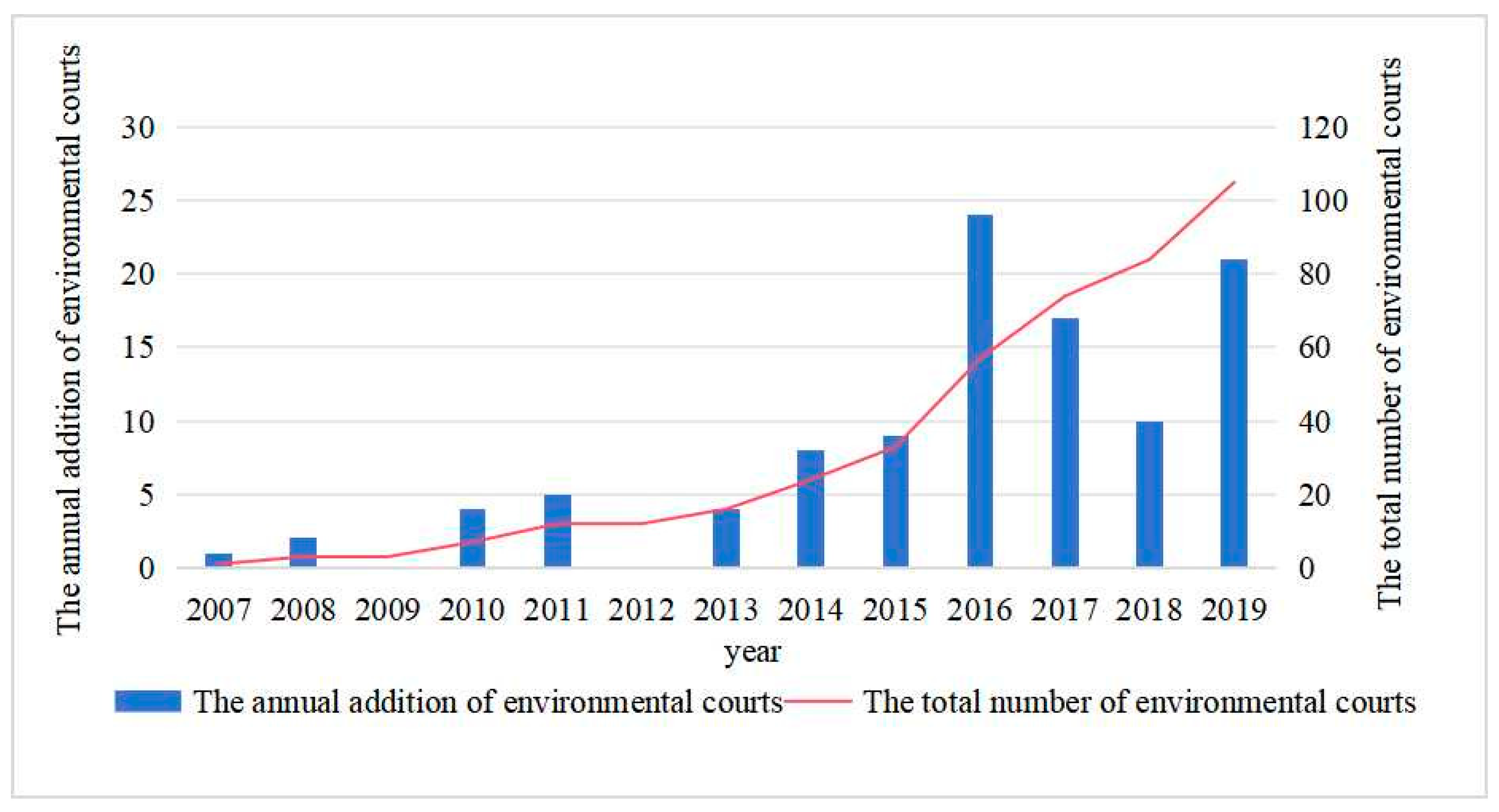
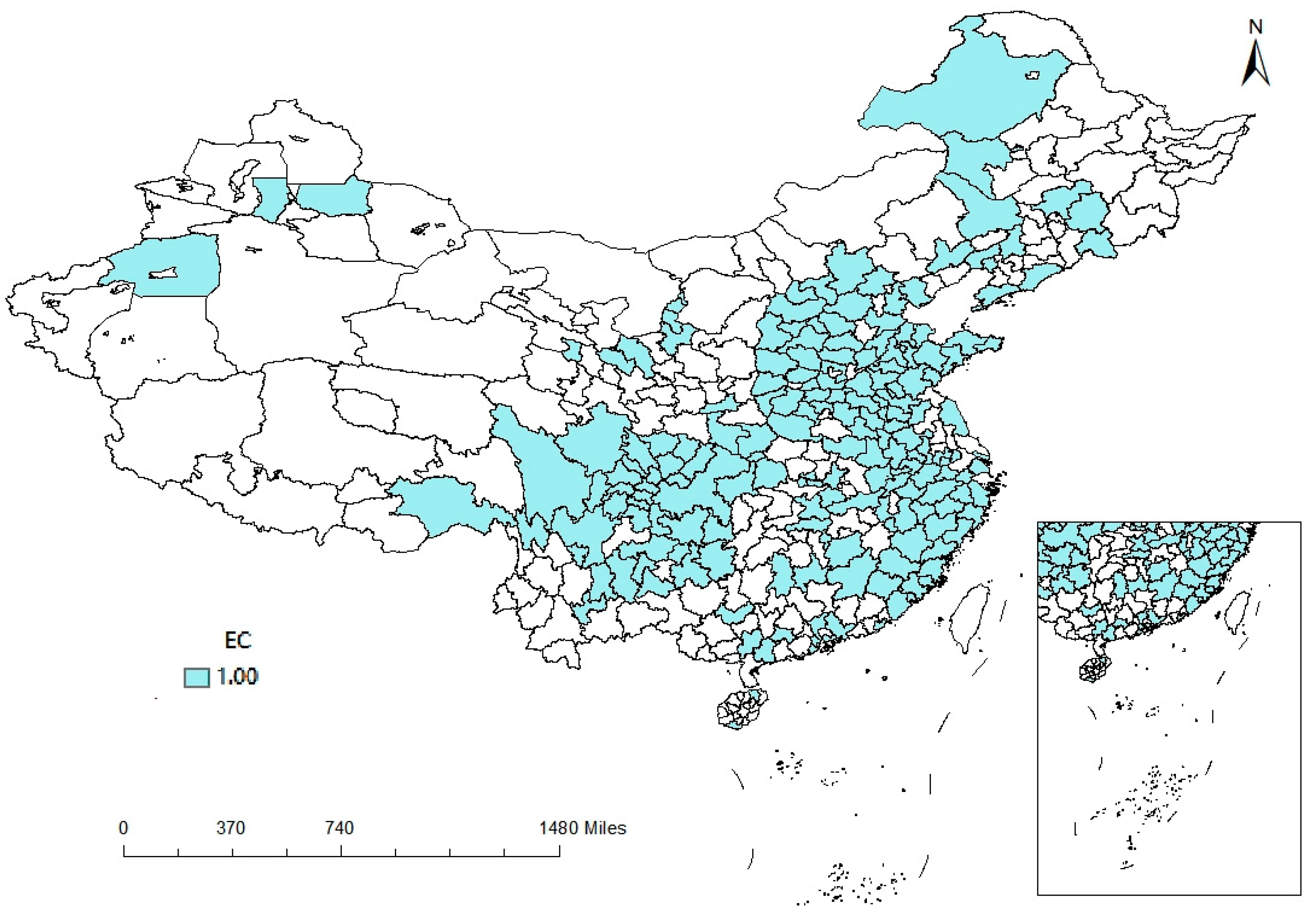
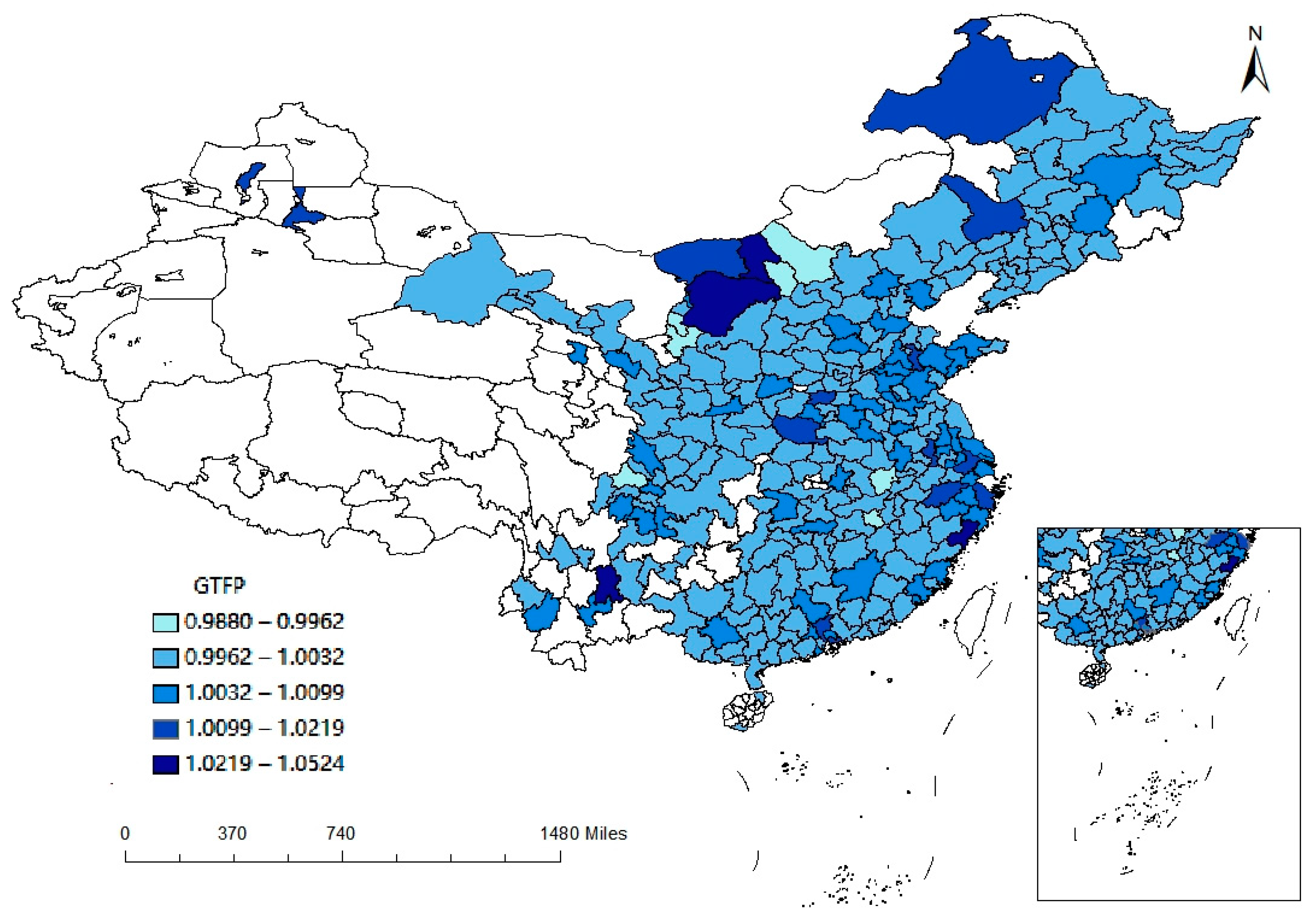
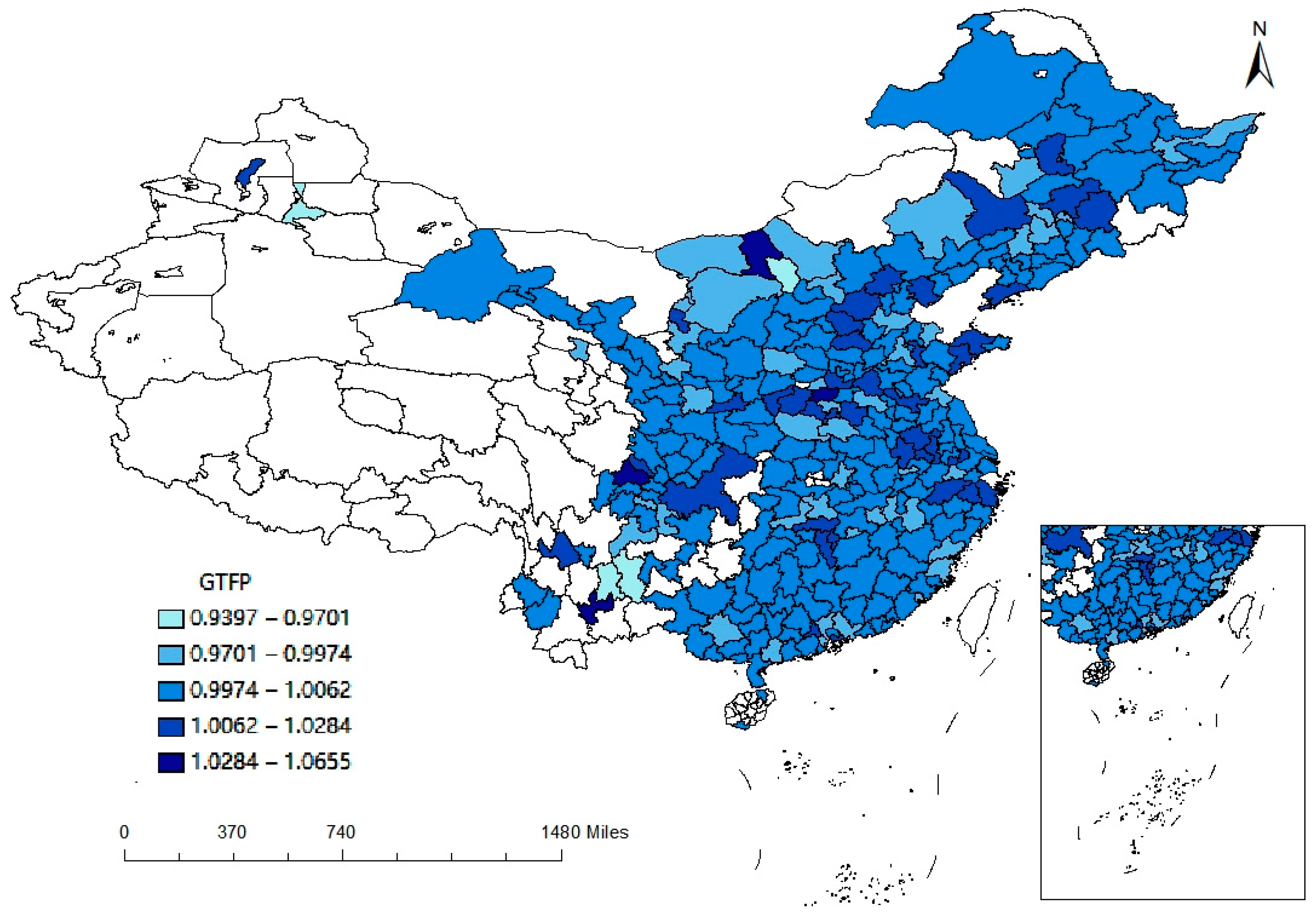
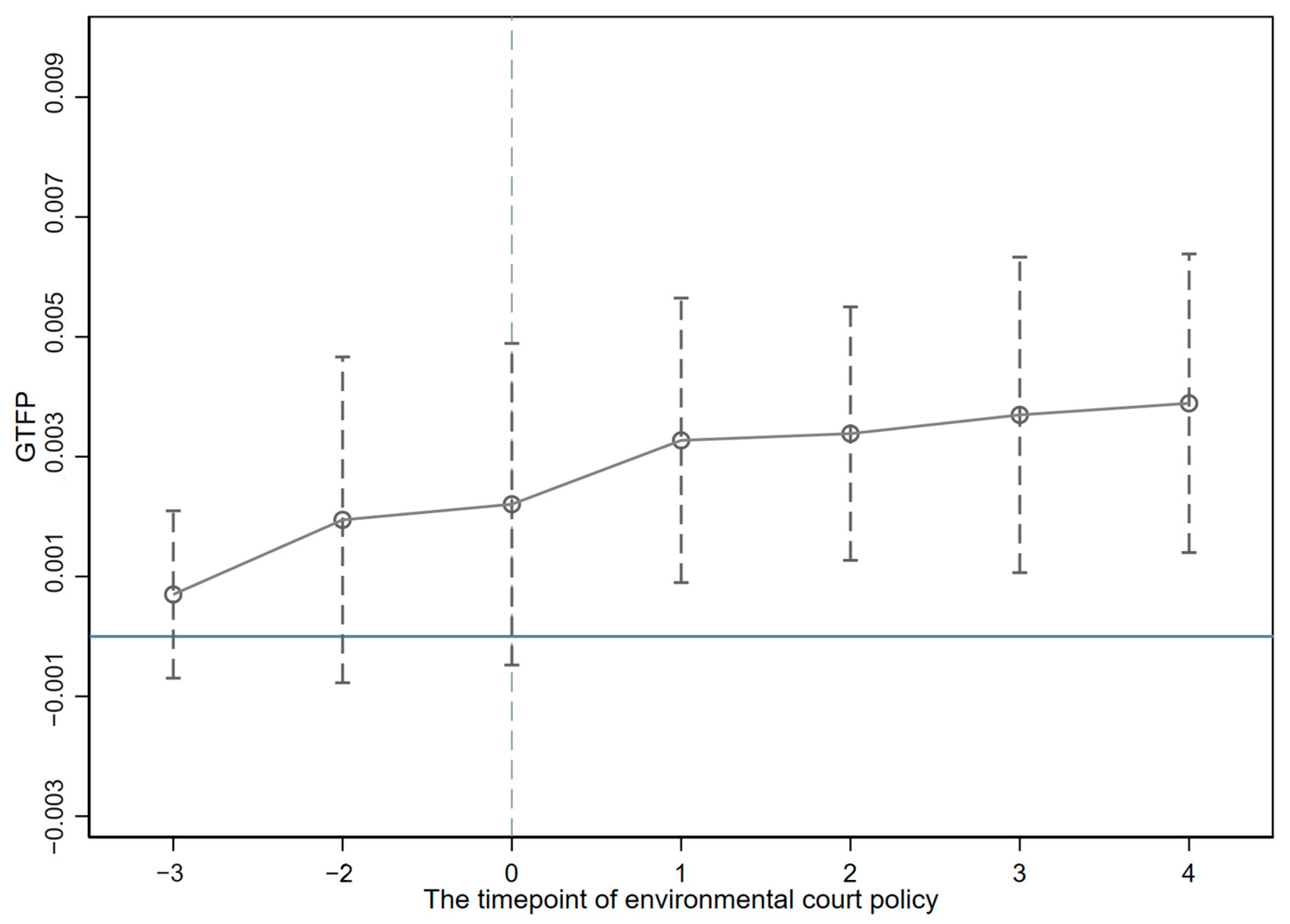
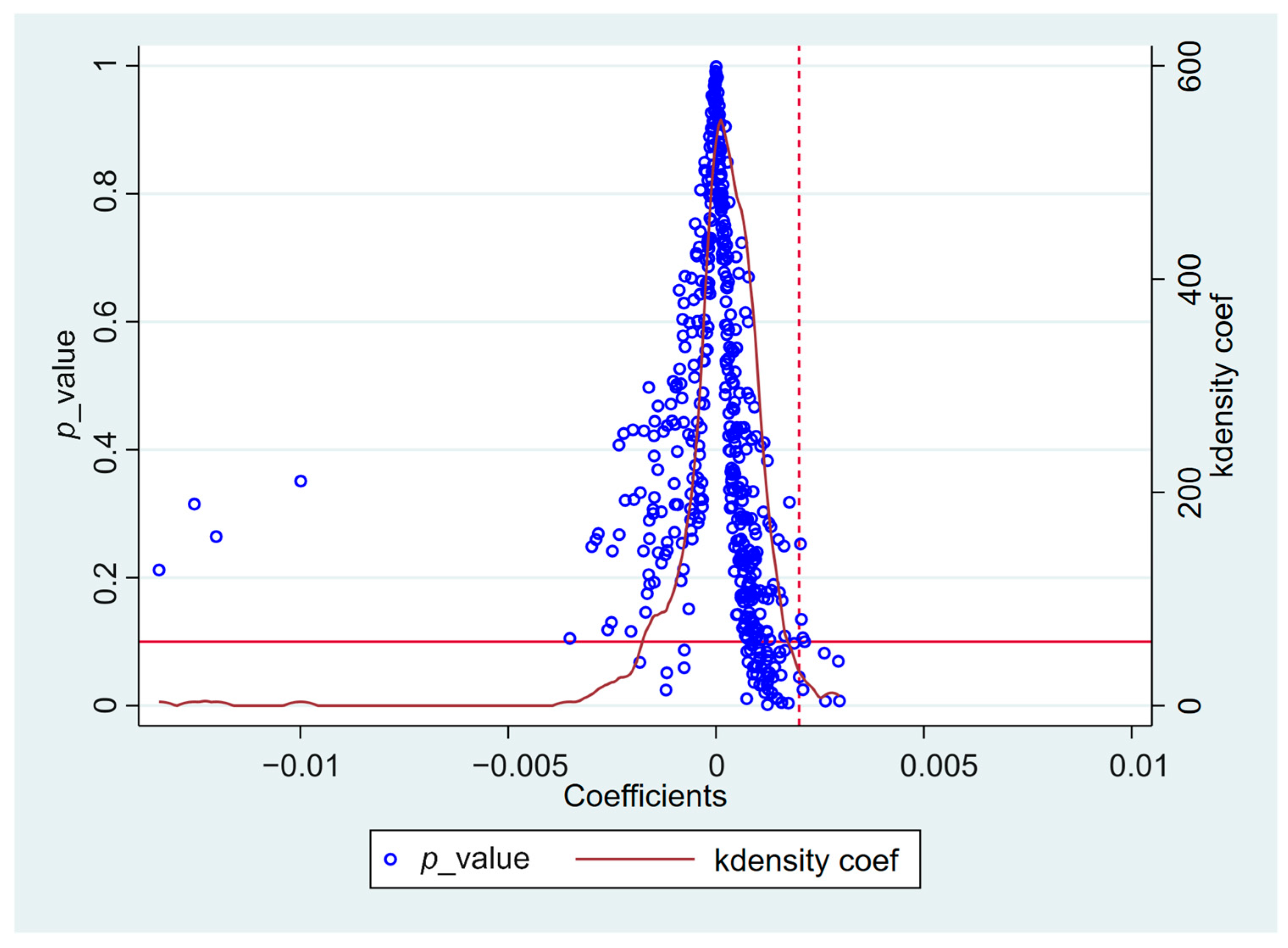
| Variable | Variable Definitions | Unit |
|---|---|---|
| gtfp | Green total factor productivity. | - |
| ec | Dummy variable for environmental courts: assigned as 1 if environmental court exists; otherwise, assigned as 0. | - |
| pergdp | GDP per capita at the end of the year. | CNY10000 per person |
| gdp02 | The proportion of the secondary industry to GDP. | % |
| gdp03 | The proportion of the tertiary industry to GDP. | % |
| edu | The number of universities per million people. | per million people |
| fin | The ratio of local general public budget expenditure to GDP. | % |
| ci | The carbon emission per unit of GDP. | tons/CNY10000 |
| er | The proportion of the frequency of environmental protection vocabulary appearing in the government work report to the total vocabulary frequency. | % |
| loa | The ratio of year-end outstanding loans of financial institutions to GDP. | % |
| green | The proportion of green patent applications to total patent applications. | % |
| ecw | Dummy variables for regions: assigned as 1 for the eastern region of China, 2 for the central region of China, and 3 for the western region of China. | - |
| lc | The dummy variable for low-carbon city pilot projects: assigned as 1 if it belongs to a low-carbon city pilot project; otherwise, assigned as 0. | - |
| Variable | N | Mean | SD | Min | Max |
|---|---|---|---|---|---|
| gtfp | 4511 | 1.003 | 0.024 | 0.505 | 1.983 |
| ec | 4511 | 0.096 | 0.294 | 0.000 | 1.000 |
| pergdp | 4511 | 3.456 | 4.198 | 0.215 | 52.050 |
| gdp02 | 4511 | 0.476 | 0.112 | 0.000 | 0.910 |
| gdp03 | 4511 | 0.390 | 0.101 | 0.000 | 0.853 |
| edu | 4511 | 1.778 | 2.172 | 0.000 | 26.610 |
| fin | 4511 | 0.226 | 0.146 | 0.007 | 1.407 |
| ci | 4511 | 5.245 | 5.799 | 0.091 | 72.810 |
| er | 4312 | 0.005 | 0.002 | 0.000 | 0.018 |
| loa | 4511 | 1.146 | 0.846 | 0.133 | 14.880 |
| green | 4511 | 0.084 | 0.041 | 0.000 | 0.610 |
| ecw | 4511 | 1.936 | 0.801 | 1.000 | 3.000 |
| lc | 4511 | 0.189 | 0.391 | 0.000 | 1.000 |
| (1) | (2) | |
|---|---|---|
| lngtfp | lngtfp | |
| ec | 0.00234 *** | 0.00212 *** |
| (0.00058) | (0.00058) | |
| lnpergdp | 0.00301 ** | |
| (0.00143) | ||
| lngdp02 | 0.00366 * | |
| (0.00208) | ||
| lngdp03 | 0.00480 | |
| (0.00309) | ||
| lnedu | −0.00230 ** | |
| (0.00106) | ||
| lnfin | 0.00045 | |
| (0.00158) | ||
| _cons | 0.00223 *** | 0.00812 ** |
| (0.00006) | (0.00323) | |
| City fixed effect | Yes | Yes |
| Year fixed effect | Yes | Yes |
| N | 4511 | 4464 |
| R2 | 0.018 | 0.018 |
| (1) | (2) | |
|---|---|---|
| PSM-DID | PSM-DID | |
| ec | 0.00222 * | 0.00211 * |
| (0.00121) | (0.00119) | |
| _cons | 0.00248 *** | 0.01470 |
| (0.00040) | (0.01080) | |
| Control | No | Yes |
| City fixed effect | Yes | Yes |
| Year fixed effect | Yes | Yes |
| N | 4464 | 4464 |
| R2 | 0.199 | 0.203 |
| (2) | (2) | |
|---|---|---|
| lnci | lner | |
| ec | −0.04520 *** | 0.12100 *** |
| (0.01050) | (0.03240) | |
| _cons | 1.43000 *** | −5.40500 *** |
| (0.06330) | (0.18500) | |
| Control | Yes | Yes |
| City fixed effect | Yes | Yes |
| Year fixed effect | Yes | Yes |
| N | 4464 | 4258 |
| R2 | 0.989 | 0.616 |
| (2) | (2) | |
|---|---|---|
| lnloa | lngreen | |
| ec | 0.00141 * | 0.00978 *** |
| (0.00074) | (0.00341) | |
| ec*lnloa | 0.00223 ** | |
| (0.00112) | ||
| lnloa | −0.00071 | |
| (0.00061) | ||
| ec*lngreen | 0.00328 ** | |
| (0.00136) | ||
| lngreen | −0.00016 | |
| (0.00177) | ||
| _cons | 0.00952 *** | 0.00899 ** |
| (0.00337) | (0.00402) | |
| Control | Yes | Yes |
| City fixed effect | Yes | Yes |
| Year fixed effect | Yes | Yes |
| N | 4258 | 4406 |
| R2 | 0.019 | 0.019 |
| (1) | (2) | (3) | |
|---|---|---|---|
| lngtfp | lngtfp | lngtfp | |
| Eastern Cities | Central Cities | Western Cities | |
| ec | 0.00119 ** | 0.00156 ** | 0.00368 * |
| (0.000595) | (0.000713) | (0.00207) | |
| _cons | −0.00274 | 0.00601 | 0.0182 ** |
| (0.00419) | (0.00467) | (0.00887) | |
| Control | Yes | Yes | Yes |
| City fixed effect | Yes | Yes | Yes |
| Year fixed effect | Yes | Yes | Yes |
| N | 1600 | 1586 | 1278 |
| R2 | 0.253 | 0.015 | 0.024 |
| (1) | (2) | |
|---|---|---|
| lngtfp | lngtfp | |
| Non-Low-Carbon | Low-Carbon | |
| ec | 0.00150 ** | 0.00229 |
| (0.000623) | (0.00182) | |
| _cons | 0.0105 *** | 0.00729 |
| (0.0037) | (0.0235) | |
| Control | Yes | Yes |
| City fixed effect | Yes | Yes |
| Year fixed effect | Yes | Yes |
| N | 3612 | 851 |
| R2 | 0.018 | 0.15 |
Disclaimer/Publisher’s Note: The statements, opinions and data contained in all publications are solely those of the individual author(s) and contributor(s) and not of MDPI and/or the editor(s). MDPI and/or the editor(s) disclaim responsibility for any injury to people or property resulting from any ideas, methods, instructions or products referred to in the content. |
© 2024 by the authors. Licensee MDPI, Basel, Switzerland. This article is an open access article distributed under the terms and conditions of the Creative Commons Attribution (CC BY) license (https://creativecommons.org/licenses/by/4.0/).
Share and Cite
Shao, S.; Qiao, H. The Impact of Environmental Courts on Green Total Factor Productivity in Chinese Cities. Sustainability 2024, 16, 7007. https://doi.org/10.3390/su16167007
Shao S, Qiao H. The Impact of Environmental Courts on Green Total Factor Productivity in Chinese Cities. Sustainability. 2024; 16(16):7007. https://doi.org/10.3390/su16167007
Chicago/Turabian StyleShao, Shuai, and Hongwu Qiao. 2024. "The Impact of Environmental Courts on Green Total Factor Productivity in Chinese Cities" Sustainability 16, no. 16: 7007. https://doi.org/10.3390/su16167007
APA StyleShao, S., & Qiao, H. (2024). The Impact of Environmental Courts on Green Total Factor Productivity in Chinese Cities. Sustainability, 16(16), 7007. https://doi.org/10.3390/su16167007






